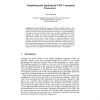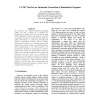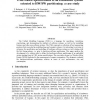OMER
2001
14 years 7 months ago
2001
: Modelling software using the Unified Modelling Language (UML) also for embedded real-time systems (ERS) becomes more and more popular since the complexity of these systems increa...
ACE
2004
14 years 7 months ago
2004
The Unified Modelling Language (UML) is a diagrammatic notation widely used in the computing industry and often taught in universities as a way to represent software requirements ...
UML
1998
Springer
14 years 9 months ago
1998
Springer
The Unified Modelling Language (UML) ostensibly assumes a four level (meta) modelling framework, both for its definition and for the conceptual context in which its users operate. ...
AIED
2007
Springer
14 years 10 months ago
2007
Springer
COLLECT-UML is a collaborative constraint-based tutor for teaching object-oriented analysis and design using Unified Modelling Language. It is the first system in the family of con...
WOSP
2000
ACM
14 years 10 months ago
2000
ACM
For sometime now, Unified Modelling Language (UML) has been accepted as a standard for designing new systems. Its array of notations helps system designers to capture their ideas ...
FDL
2003
IEEE
14 years 11 months ago
2003
IEEE
The Unified Modelling Language (UML) is a language for specifying, visualizing, constructing, and documenting the artefacts of software systems, as well as for modelling business ...



